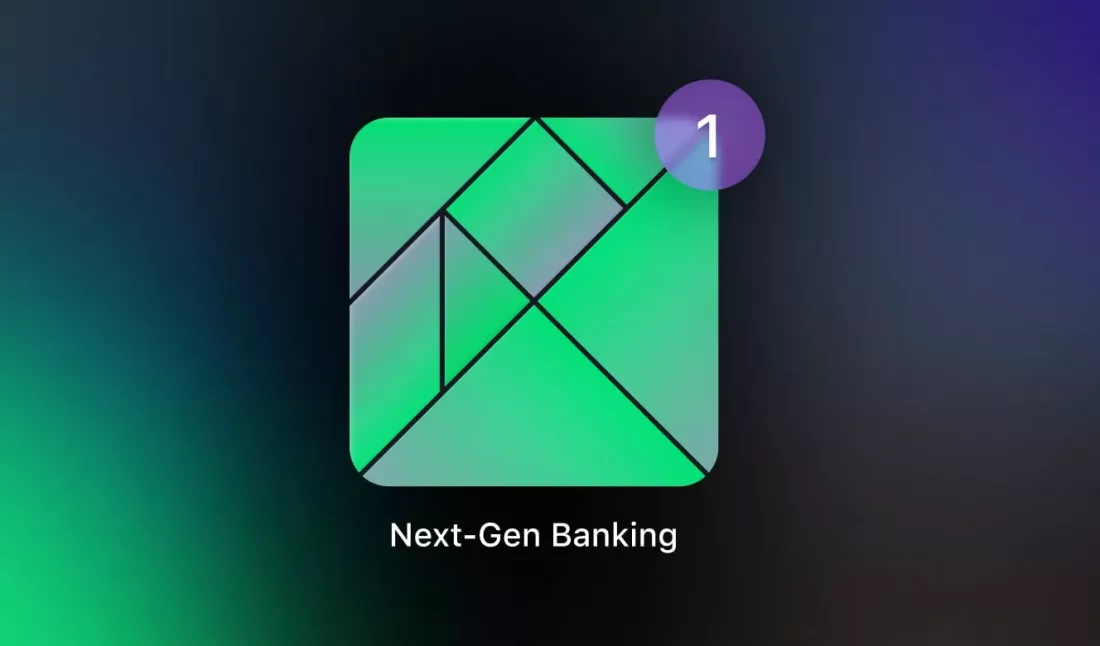2021 has been a year unlike any other: accelerated development of markets that were hit by Covid-19 drastically changed how business is done. As a result, the financial technology sphere has evolved too. So, what are the fintech trends 2022 to watch in this unsteady climate?
In this article of trends column, we’re discussing the fintech opportunities for 2022, the most trending financial technologies and approaches that are taking over the market, and think what are the next fintech ideas. Hint: ultimate digitalization and market sustainability.
Main Factors to Shape the Fintech Trends of 2022
Sustainability or the aim to “meet the needs of the present without compromising the ability of future generations to meet their own needs [1]” has become a key priority for organizations across virtually all industries.
According to Nielsen, about 60% of users are willing to pay extra for services if they come from sustainable companies. The mentioned figure reaches out to 73% among millennials. However, the movement is just at the start. The growing Generation Z hailed as the generation of sustainability is eager to spend 10% more on services and products provided by sustainable companies.

The global pandemic really contributed to the growth of sustainable services and financial industry trends. Lots of organizations worldwide recognized the need for greater resilience to crisis and phase-out of outdated systems. You might be wondering, what does this have to do with fintech?
The emergence of fintech has meant a renovation for financial organizations in terms of following the sustainability and the go-green movement. Fintech companies, unlike the other ones, have a significant advantage over traditionalists as their organizations are built around digital processes and aimed at promoting digitalization in the financial sector. Digital transformation is the key element for companies in reducing their environmental footprint, according to Mariusz Ożga, Chief Innovation Officer of Alior Bank. It allows cutting brick-and-mortar offices and eliminating paperwork by moving it online. By being more sustainable, companies can be less cost-intensive and increase margins.
A great example of sustainable collaboration is a combination of alternative risk management and lending. Let’s take a look at GiniMachine, an innovative AI-powered scoring platform that makes decisions based on historical data. When a bank wants to protect itself from reputation damage and follow ESG factors, GiniMachine allows including limitless parameters (customer data) like go-green violations, anti-environmental collaborations, etc. into scoring models to distinguish potentially risky partnerships and borrowers. The risk of being associated with non-sustainable corporations and governments will continue this approach into 2022. Moreover, with 2022 being considered as the year of the economy’s full reopen in post-pandemic, sustainable investment in the fintech industry is also likely to grow even faster. Thus, the sustainability movement is considered one of the main factors shaping fintech trends 2022 and beyond.
Read also
Top 6 Biggest Fintech Industry Trends in 2022
Fintech has had an ambitious effect on the financial and lending markets since the beginning of the 2020s. Given fintech’s growing influence on financials, 82% of financial companies (more than 4 in 5) plan to increase their fintech partnerships in the upcoming years. Considering fintech trends of 2022, vendors are flexible to any customer need in making financial services more transparent and fully digital.
Here’re the top fintech trends 2022 for companies to consider for accelerated growth.
The rise of hybrid banking and digital-only banks
According to the Financial Times, in the last four years, up to one-third of brick and mortar bank branches have been closed. But does this mean that banking trends 2022 offer us to store money under the mattress? No, quite the opposite.
Currently, for instance, 27% of UK adults have a digital-only bank account, up from 16% from January 2020. It’s a threefold increase compared to January 2019. This makes it one of the biggest trends in fintech to date not only in the UK but globally. And it’s only growing. It is estimated that by 2025 almost half of the adults will do their banking online. The success of fintech startups as Revolut, Monzo, and Starling is proof of this. They have rapidly expanded their customer bases, forcing existing banks and lenders to rethink their focus on their web applications. The development of the fintech sector has led to a shift in the industry, compelling banks to close branches.
Alongside the fintech trend on digital-only banks, traditional banks are adapting to this fintech trend with a hybrid banking approach [2]. It’s aimed at combining digital and in-house services to develop a customer-centric banking ecosystem that provides clients with an opportunity to choose access methods. More than ever before, providers are upgrading their technology stack with web and mobile apps to cater to their clients’ needs for online services. PwC defines this trend as “getting ready for the new normal,” indicating digital services are here to stay.
Blockchain as a disruptor of traditional financing
Just as the popularity of digital solutions for banking and payments grows, so too does the need for security. That digital banking trends 2022 apply to both the side of the client and the company providing the service.
According to the Global Economic Crime and Fraud Survey 2020 by PwC, 47% of companies experience fraud, the total cost of which is estimated at around $ 42 billion in losses. Not a small amount. Research shows that investing in fraud prevention rather than reacting after an event occurs is a cost-saving measure that companies can take to minimize losses.
That’s where fintech comes in. Innovative solutions such as blockchain can aid companies in keeping data secure and almost unhackable. Blockchain technology enables ultra-secure payments and transactions without any intermediaries, which significantly reduces costs. Based on the statistics, blockchain will be responsible for storing 10% of global GDP by 2025. According to the Finances Online, the technology will possibly boost the global economy to $1.76 trillion over the next decade [3].
Implementation of blockchain can reduce fraud, secure payment processing and make them smarter, drive independent client verification, and more. Meanwhile, new solutions for document reading and authentication can be used to complete vital anti-money laundering (AML) and know your customer (KYC) processes seamlessly at a distance.
This ensures businesses can keep up with the demand for distance while fulfilling even the most intimate of security processes needed to protect their company and customers.
Financial services are becoming embedded
Embedded finance is one of the hottest topics among banking trends 2022 and in the fintech world for now. It allows integrating payments, loans, and investment instruments into any non-financial service. To give an example, you can take a loan at the point of service of a furniture store to pay for a sofa without the need to go to a lender and fill out dozens of forms.
Embedded finance companies expect to reach an estimated market value of over $138 billion in 2026 and cover a market cap of $7.2 trillion globally by 2030. In addition, the embedded finance market in the US will reach under $230 billion in terms of new revenue volume by 2025 as opposed to $22.5 billion in 2020 (an increase of 922%) [4].
The success of the embedded finance model is already visible: embedded lenders such as Klarna, AfterPay, Affirm allow splitting an online purchase into several monthly payments. The embedded finance model captures a user at the moment of an urgent need and offers the perfect-fit solution. It’s forecasted that in the upcoming years, the concept will allow banks and lenders to save costs on marketing and branding as well as increase revenue per user of their digital apps by up to 5x. No wonder embedded finance seems to be the future of lending, investing, and payments.
Cashless transactions as payment innovation in fintech
However, the changes aren’t just occurring within the banking sphere — the usage of mobile payment systems in growing too. The mobile payment sector is expected to reach a CAGR of 3.66% between 2019-2024.
PayPal, Amazon, Alphabet Inc, and Alipay.com are the innovative web businesses leading the evolution. Yet alongside them appear traditional financial stalwarts, such as Visa and Mastercard, who both have recently heavily invested in financial technology acquisitions.
As the mobile payment demand grows, especially in the current post-covid contactless climate, China, the US, Japan, the UK, and Korea are leading the pack in developing cashless societies. While we hope coronavirus will soon be a distant memory, it’s clear that some of its effects, such as contactless payments, will only grow.
Big Data for a customer-centric approach
Data, analysis, and personalization are more critical now than ever before. The days of out-of-the-box solutions for all customers are long gone. Big Data has broad applications across business, affecting the work of all departments from Product to Design to Content. Yet one of its brightest uses, in recent times, is in the customer service sphere.
In 2020, Covid-19 forced offices to move to remote working, a move many were not prepared for. Yet, the demand from customers didn’t slow down. Many had questions on everything from orders to security and everything in between. However, there were simply not enough specialists to fulfill all requests quickly. Enter Big Data.
Big Data allows companies to analyze the most frequently asked questions to create customer-focused chatbots that help clients solve issues without the need for a physical customer service specialist.
For example, Alipay (a fintech payment platform) handles between two to three million requests a day. It is said to be between 30-60% more efficient, in terms of processing speed, at addressing concerns than human handling the request.
But, does this mean we should go all-in on Big Data and digital chatbots over human customer service? Not quite yet. AI and Big Data are advancing company capabilities, but they can’t replace a human agent. Instead, they allow that employee to focus on more complicated issues and focus on client satisfaction.
Lending risk assessment to prevent mortgage collapse
Across the world, many governments issued loans to support businesses during crisis lockdowns. However, many states struggled to meet demand, were not inclusive in all cases, or were slow to materialize, putting smaller enterprises in particular at risk. This, coupled with unheard of restrictions, left many companies incredibly vulnerable over the short term and at risk of permanent closure.
Although the Covid cases seem to decrease, the US market still meets an ever-increasing demand for mortgage loans, as Fortune states. Real estate has been going up by $20,000 each week for the past months, while the demand continues to rise. As a result, lenders seek for risk assessment solutions in order not to fail.
The early months of the crisis were marked by an almost 200% increase in demand for lending services. So, it’s no surprise the private lending sector was quick to step up. Yet, even in times of great need is the potential of high risk.
Like the opportunities, in 2021, risks are evolving more rapidly than ever before, and in no sphere is this more important than the insurance sector. Properly assessing risk is a critical component of any insurance company. Yet, in the current coronavirus environment, this is not as straightforward as it might once have been, and new solutions are required to assess the risk for providers adequately.
Take, for example, a previously mentioned GiniMachine – a machine learning and artificial intelligence fintech platform that focuses on consumer and business lending mainly. The role of this technology is to help build credit scoring models, enabling businesses to make smarter lending decisions. As the instability of 2021 is set to continue, such technological solutions are vital to help lenders correctly and accurately analyze real risks, while capitalizing on the potential of the rapidly progressing situation.
Read also
What Fintech Industry Trends to Take Away?
2021 might have been a challenging year for many. Yet, as Albert Einstein said, “In the middle of difficulty, lies opportunity.” So, as we continue to struggle with the coronavirus pandemic and all the challenges that have arisen throughout previous years, there is one thing we can say for sure — the fintech landscape has changed exponentially.
Looking ahead for the rest of the year and into 2022, we’re excited to see what advancements will be achieved and fintech ideas will become widespread to the world.
Interested in fintech opportunities for lending? Get in touch with HES FinTech for top-notch software.

















